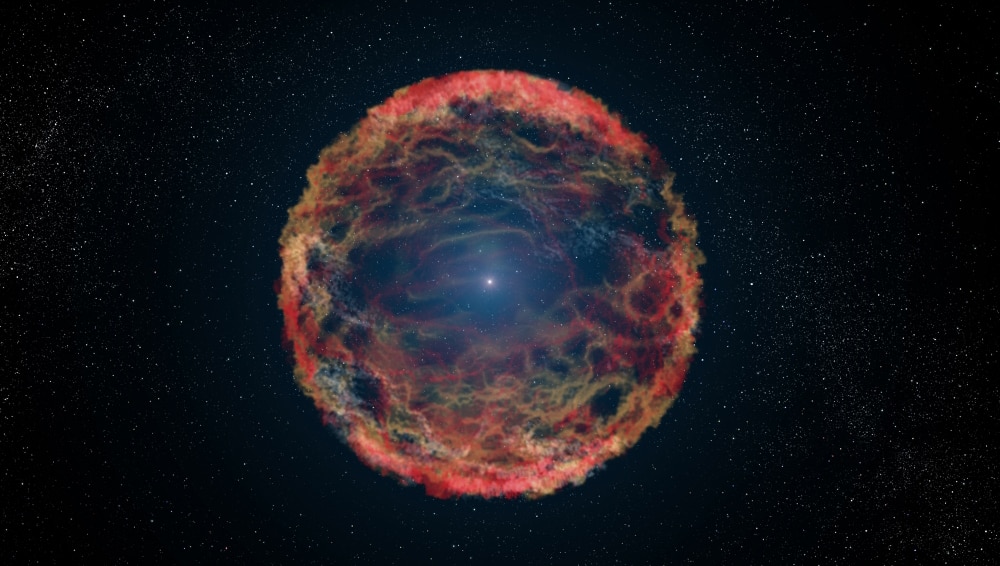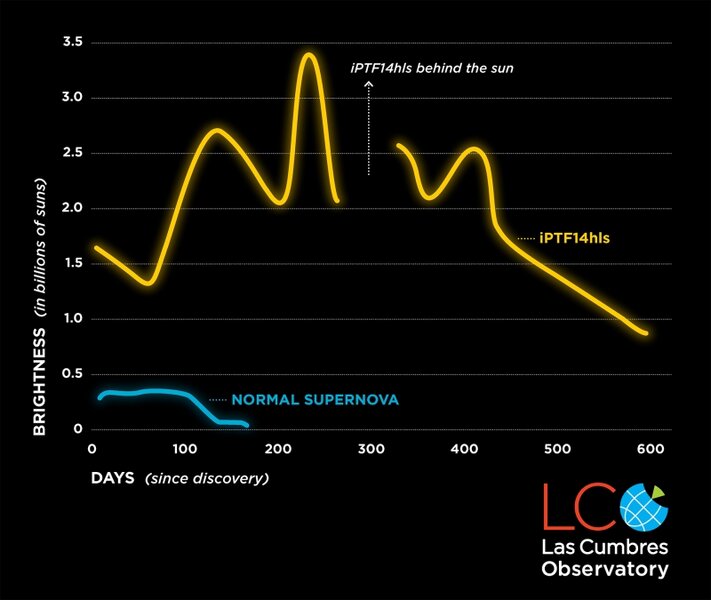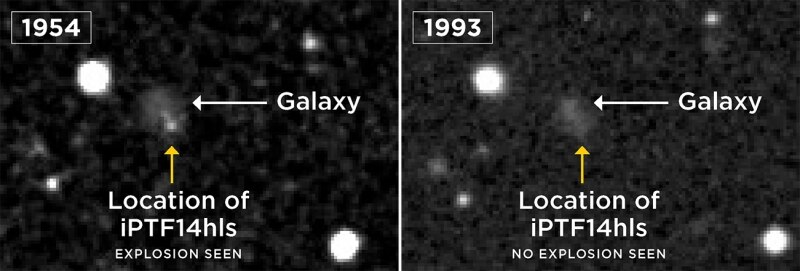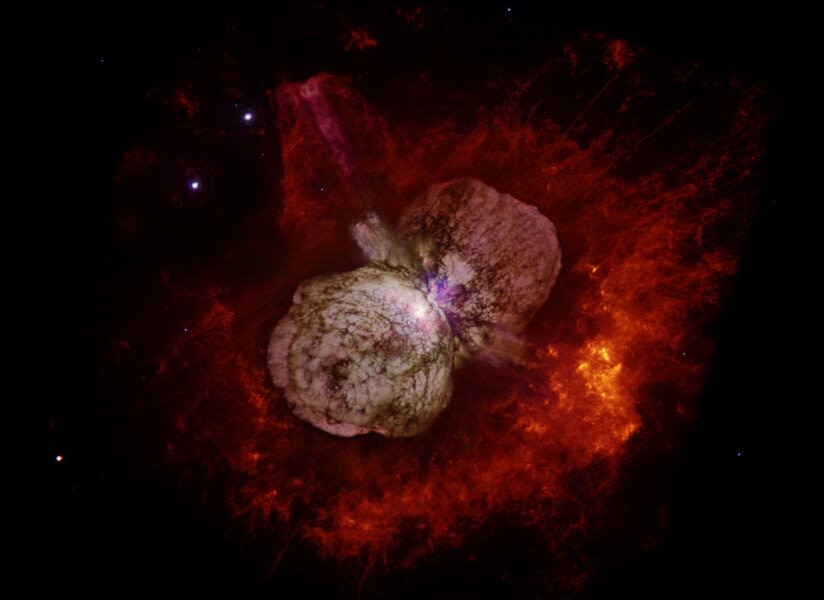Create a free profile to get unlimited access to exclusive videos, sweepstakes, and more!
The star that blew up a little...then blew up a lot

A supernova is the cataclysmic end to a massive star's life. The entire process is (of course) somewhat complicated, but in a nutshell it runs out of fuel in its core, the core collapses, a vast amount of energy is released, the outer layers explode, and all that matter and energy gets blasted out into space.
The core can become a neutron star or a black hole (it’s even possible it gets torn apart in the blast), and the expanding gas cloud can do all sorts of interesting things, but for the star itself that’s the end of the story. It’s gone.
But up until that final cataclysm, the star can still undergo some pretty violent, near-supernova-level outbursts. Astronomers have found such a supernova, with a least one epic paroxysm or two before the last explosion destroyed it … and the supernova event may be the most powerful ever seen.
The supernova in question was in an unnamed galaxy about 500 million light-years from Earth (which is a fair distance away). It was found using the Intermediate Palomar Transient Factory (iPTF), a very large camera that is mounted on a relatively small 1.2-meter telescope. It is a fully automatic survey that scans the sky looking for things that change — asteroids, various variable stars, and the like. If a supernova goes off, a spot on the sky gets brighter, and if iPTF is looking that way and the explosion is bright enough, iPTF will find it.
The software flagged the supernova, and it was quickly determined to be what’s called a Type II: a massive star exploding. Furthermore, it’s a Type II-P: Instead of simply getting brighter and then fading as most Type IIs do, the fading plateaued (hence the P), staying at a constant brightness for some time. These are not uncommon, and usually start to fade again after a few weeks or so. This happens because the huge mass of exploded material is opaque to radiation, so we only see the surface of it. As it expands and cools the outermost parts become transparent, and we see light emitted from further inside the expanding material. The expansion outward and the depth into which we see the hot material inward kinda sorta balance, and the total light emitted stays constant. At some point the expanding material becomes wholly see-through, and the light fades.
But after a little while astronomers saw that this new supernova, called iPTF14hls, wasn’t playing by the rules. Instead of fading after a few weeks, it kept on staying constant. For months. Then years. The plateau phase has lasted 600 days. So far.
That’s incredible. The amount of energy this thing emits is phenomenal, and it’s been blasting it out for longer than any other supernova known. This could make it the most powerful total supernova event ever seen.
But there’s a lot more weirdness here.
Usually in a Type II-P the light gets bright in the initial explosion, fades a bit, then plateaus. But iPTF14hls broke this rule as well: It kept fluctuating in brightness, intensifying and fading at least four times after the initial explosion! No supernova has ever done that before.
This behavior implies the star had undergone previous explosive events, powerful enough that they would have ejected a lot of material (dozens of times the Sun’s mass in just the first event alone). The fluctuations in light and the plateau might then be explained by the actual final supernova energy slamming into that older stuff. That’s unprecedented and pretty strange, but not impossible.
But then it got truly weird: It appears to have exploded once before. In 1954.
The astronomers looked at archived data of the same galaxy, and found an old image that seems to show the a blast of light at the same spot as iPTF14hls, except it was in a sky survey taken over 60 years ago. Given the distance, the amount of energy emitted in that outburst was pretty flippin’ close to being that of a supernova itself! How is that possible?
The bottom line is, we don’t know. It’s clear this 1954 explosion was not an actual supernova, but still a colossal event. And there’s an interesting idea that could explain this, at least partially: antimatter.
Now hang on. I’m not saying the star is made of antimatter. Well, wait. I guess I kind of am. At least, maybe a little bit of it was, and that’s what might have caused all this mess.
What follows is still somewhat hypothetical, but astronomers are working on this problem, and many think this can explain this very odd class of exploding star …
As I said above, a supernova occurs when a star runs out of fuel in its core. This happens with stars that have masses with at least 20 or so times the mass of the Sun.
However, things change if the star has a lot of mass. Like, a lot. The range isn’t clear, but if it has more than about 130 times the mass of the Sun — that’s a huge amount, making this a singularly terrifying star — the conditions in the core get weird. At first it evolves the same way a normal massive star does: It fuses hydrogen into helium, then helium into carbon, then carbon into neon … and the energy generated in each cycle supports the ponderous bulk of the core.
But as oxygen builds up in the core from the neon fusion in this enormous star, things change. The core is extremely hot — over a billion degrees! — and can have a mass more than 50 times the Sun’s. Neon fusion produces a lot of extremely high-energy gamma rays, a form of light that has a million or more times the energy of the kind of light we see. These gamma rays contain so much energy they help keep the core hot. This heat balances the force of gravity trying to collapse the core, achieving something of an equilibrium.
This is where the star gets in trouble. You may have heard that Einstein’s famous equation E=mc2 means that matter can be converted into (a lot of) energy. That’s how stars shine; the fusion of atomic nuclei converts matter into energy! But the reverse is true as well: Energy can be converted into matter.
Gamma rays are energy. In the core of the massive star, the gamma rays have so much energy that when they interact with the matter around them they can actually convert into matter themselves, creating an electron/positron pair (a positron is a particle of antimatter, the counterpart of an electron).
Remember, though, that it’s these gamma rays that are helping support the massive weight of the core of the star. If enough of them convert to matter, that support goes away. That’s bad.
If it happens suddenly enough, the loss of support from gamma rays means the core’s gravity will cause it to shrink violently, essentially collapsing. The temperature and density go way up. At this point one of two things can happen, neither of which is good.
One is that this triggers a catastrophic wave of nuclear fusion in the core. A soul-crushing amount of energy is released, billions of times what the Sun emits. This rips apart the star, tearing through the outer layers and causing a vast supernova. The star explodes. We call that a pair-instability supernova.
But, if the mass of the core is just right, the amount of energy released acts like a bit like pressure valve. Instead of collapsing, the core just gets mightily squeezed. A huge energy pulse is released, but not enough to blow the star up.
It inflicts heavy damage, though. A ridiculous amount of material can be ejected from the star, and this blows out into space. After this almost-catastrophic pulse, the core is still making oxygen from neon fusion, so this can happen again. You might get another pulse, or this one could blow the star up. This may even happen several times.
But inevitably, in the end the star blows up. And this does sound a lot like iPTF14hls: Huge blasts of energy that look like a supernova, but aren’t quite. Then the star really does blow, and that energy sweeps through the older material surrounding the star, causing the emitted light to behave oddly, peaking and dropping and peaking again.
In a sense, though, this is handwaving; while it fits the observations, you need to look at the physics in detail to make sure this can actually happen. And at the moment, the physics doesn’t quite work. For example, the models show that most of the hydrogen in the outer layers gets blown off in the first pulse, but the star that blew up to form iPTF14hls seems to have retained a few dozen times the Sun’s mass worth of hydrogen in its outer layers after the 1954 event. It’s not clear how that could happen.
And while that event was incredibly powerful, it wasn’t really a supernova, but something that fell just short of one. It seems to die but it keeps coming back. iPTF14hls is the Rory Williams of supernovae.
This all reminds me strongly of the star Eta Carinae: Another substantially hefty star that also emitted a huge pulse of energy that was seen in the 1800s. It blew out two ridiculously massive lobes of gas, each many times the mass of the Sun, and the energy involved was less than but similar to a supernova. This may have been a pair production instability pulse, but to be honest no one knows. It’s possible that Eta Car and iPTF14hls are siblings in a sense, and may have similar conditions governing their behavior.
I suspect that we’ll see more objects like iPTF14hls in the future. Though not many! Stars with a hundred or more times the mass of the Sun are extraordinarily rare — conditions need to be just right to let a star grow to such monstrous size, and we don’t really understand how they work. Our physics is just now getting good enough to understand how stars explode; we need very fast computers and an understanding of all the players in the core (including gamma rays, matter-antimatter pairs, neutrinos, and a host more) so that we can determine just what happens in the center of the inferno.
iPTF14hls is an oddity for now, but it likely won’t be for long. The more of these objects we see, the better we’ll know them.

















